2016年12月10日雅思考试真题及答案解析
- 格式:docx
- 大小:24.65 KB
- 文档页数:3
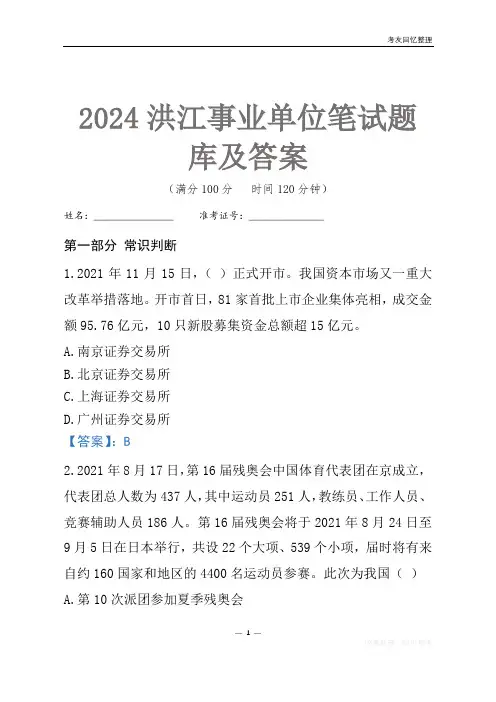
2024洪江事业单位笔试题库及答案(满分100分时间120分钟)姓名:________________ 准考证号:_______________第一部分常识判断1.2021年11月15日,()正式开市。
我国资本市场又一重大改革举措落地。
开市首日,81家首批上市企业集体亮相,成交金额95.76亿元,10只新股募集资金总额超15亿元。
A.南京证券交易所B.北京证券交易所C.上海证券交易所D.广州证券交易所【答案】:B2.2021年8月17日,第16届残奥会中国体育代表团在京成立,代表团总人数为437人,其中运动员251人,教练员、工作人员、竞赛辅助人员186人。
第16届残奥会将于2021年8月24日至9月5日在日本举行,共设22个大项、539个小项,届时将有来自约160国家和地区的4400名运动员参赛。
此次为我国()A.第10次派团参加夏季残奥会—1 —B.第16次派团参加夏季残奥会C.第8次派团参加夏季残奥会D.第3次派团参加夏季残奥会【答案】:A3.刘禹锡的《酬乐天扬州初逢席上见赠》所属的诗歌类型是:()A.山水诗B.讽谕诗C.感遇诗D.咏史诗【答案】:C4.以下有关我国古代军事成就的说法错误的是:A.我国是世界上最早使用火炮的国家B.十八般兵器的构想很多来自于动物C.我国唐朝时开始在军事上使用地雷D.我国是军事上运用沙盘最早的国家【答案】:C5.商品的交换原则是()。
A.公平原则B.平等原则C.等价原则D.赢利原则【答案】:C—2 —6.小王家农场自产的水果,一部分卖给水果批发市场,一部分作为福利发放给农场的工人。
则作为福利的这部分水果()。
A.计算进国民生产总值,按照水果的市场价格核算B.不计算进国民生产总值,因为发放福利是让员工自己使用,不属于市场行为C.计算进国民生产总值,按照水果的成本价核算D.不计算进国民生产总值,因为发放福利不属于生产行为【答案】:B7.春秋战国时代,诸子百家大多站在民众一边,替百姓打算,唯有一家专替君主打算,这家是()。
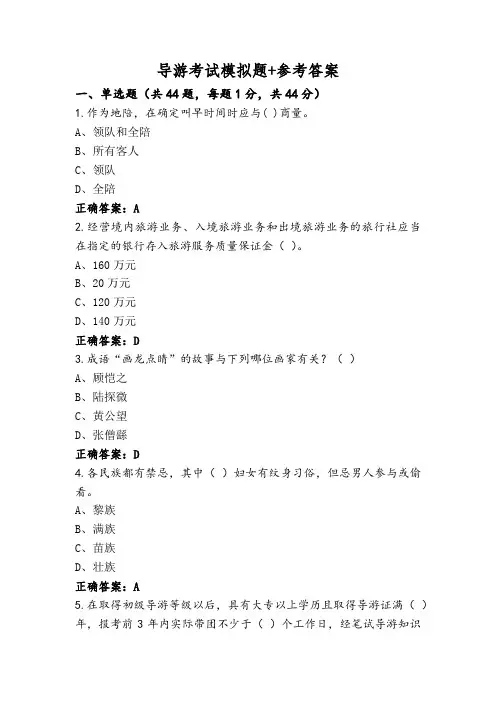
导游考试模拟题+参考答案一、单选题(共44题,每题1分,共44分)1.作为地陪,在确定叫早时间时应与( )商量。
A、领队和全陪B、所有客人C、领队D、全陪正确答案:A2.经营境内旅游业务、入境旅游业务和出境旅游业务的旅行社应当在指定的银行存入旅游服务质量保证金()。
A、160万元B、20万元C、120万元D、140万元正确答案:D3.成语“画龙点睛”的故事与下列哪位画家有关?()A、顾恺之B、陆探微C、黄公望D、张僧繇正确答案:D4.各民族都有禁忌,其中()妇女有纹身习俗,但忌男人参与或偷看。
A、黎族B、满族C、苗族D、壮族正确答案:A5.在取得初级导游等级以后,具有大专以上学历且取得导游证满()年,报考前3年内实际带团不少于()个工作日,经笔试导游知识专题、汉语言文学知识或外语,合格者晋升为中级导游员。
A、3,90B、3,80C、2,80D、2,90正确答案:D6.第十二届全国人民代表大会常务委员会第十一次会议决定,我国国家“宪法日”为()。
A、10月30日B、12月30日C、12月4日D、6月30日正确答案:C7.《周易》中的八卦象征着八种基本自然现象,其中乾、坤、坎、离卦象征的是()。
A、天、地、山、水B、天、地、雷、风C、天、地、山、风D、天、地、水、火正确答案:D8.下列工作不属于全陪导游职责范围的是()。
A、景点讲解B、致欢送词C、维护游客安全D、处理团队事务正确答案:A9.按照蒙古族习俗,人们到蒙古包做客,忌讳其坐在蒙古包的()。
A、东南角B、东北角C、西北角D、西南角正确答案:C10.导游员小张在带团过程中擅自决定在行程单上减少一处游览景点,该景点门票价格为80元,旅游费用总额2000元,那么旅行社应当向旅游者赔偿()。
A、160元B、200元C、80元D、100元正确答案:A11.在导游讲解中,较为理想的语速应控制在每分钟()左右。
A、150字B、250字C、300字D、200字正确答案:D12.有“花中君子”之誉的花卉是()。
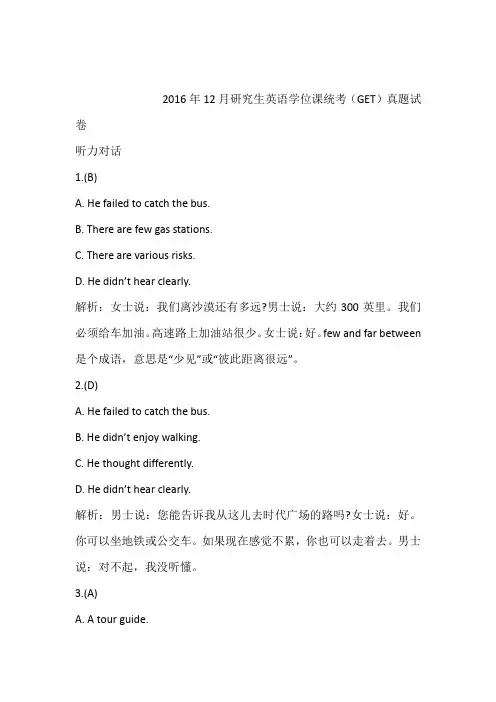
2016年12月研究生英语学位课统考(GET)真题试卷听力对话1.(B)A. He failed to catch the bus.B. There are few gas stations.C. There are various risks.D. He didn’t hear clearly.解析:女士说:我们离沙漠还有多远?男士说:大约300英里。
我们必须给车加油。
高速路上加油站很少。
女士说:好。
few and far between 是个成语,意思是“少见”或“彼此距离很远”。
2.(D)A. He failed to catch the bus.B. He didn’t enjoy walking.C. He thought differently.D. He didn’t hear clearly.解析:男士说:您能告诉我从这儿去时代广场的路吗?女士说:好。
你可以坐地铁或公交车。
如果现在感觉不累,你也可以走着去。
男士说:对不起,我没听懂。
3.(A)A. A tour guide.B. A bus driver.C. A hotel attendant.D. A traffic policewoman.解析:女士说:各位请注意。
我们今天的日程安排是首先参观故宫。
在故宫附近的饭店午餐后,我们去颐和园。
我们很可能晚上七点左右回到宾馆。
男士说:我们晚上自由活动吧?女士说:是的,我们没有什么特别安排。
4.(C)A. He was rude to his mother.B. He loves his girlfriend.C. He can tolerate his girlfriend no more.D. He insulted his girlfriend.解析:女士说:我听说你跟女朋友分手了。
是吗?男士说:是的。
她对我一直很不友好。
最无法忍受的是她说我妈妈的坏话。
the last straw 的含义是it is the latest in a series of bad events,and it makes you unable to deal with a situation any longer,也就是“一系列令人不愉快的事情中,最后一件让你忍无可忍的事”。
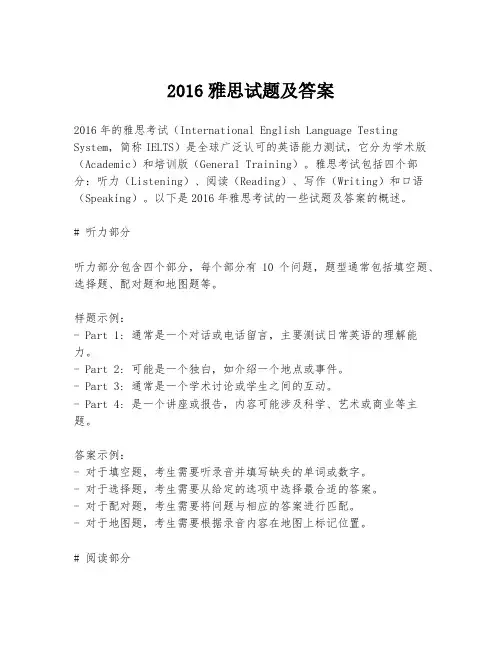
2016雅思试题及答案2016年的雅思考试(International English Language Testing System,简称IELTS)是全球广泛认可的英语能力测试,它分为学术版(Academic)和培训版(General Training)。
雅思考试包括四个部分:听力(Listening)、阅读(Reading)、写作(Writing)和口语(Speaking)。
以下是2016年雅思考试的一些试题及答案的概述。
# 听力部分听力部分包含四个部分,每个部分有10个问题,题型通常包括填空题、选择题、配对题和地图题等。
样题示例:- Part 1: 通常是一个对话或电话留言,主要测试日常英语的理解能力。
- Part 2: 可能是一个独白,如介绍一个地点或事件。
- Part 3: 通常是一个学术讨论或学生之间的互动。
- Part 4: 是一个讲座或报告,内容可能涉及科学、艺术或商业等主题。
答案示例:- 对于填空题,考生需要听录音并填写缺失的单词或数字。
- 对于选择题,考生需要从给定的选项中选择最合适的答案。
- 对于配对题,考生需要将问题与相应的答案进行匹配。
- 对于地图题,考生需要根据录音内容在地图上标记位置。
# 阅读部分阅读部分包含三篇文章,每篇文章后面有若干问题,题型包括判断题、填空题、选择题和简答题等。
样题示例:- Passage 1: 通常较短,内容可能涉及日常生活或社会问题。
- Passage 2: 中等长度,可能涉及更专业或学术性的主题。
- Passage 3: 最长,内容可能非常专业或复杂,需要较高的阅读和理解能力。
答案示例:- 对于判断题,考生需要根据文章内容判断陈述是否正确。
- 对于填空题,考生需要从文章中找到信息并填写在空白处。
- 对于选择题,考生需要从给定的选项中选择最合适的答案。
- 对于简答题,考生需要用自己的话简要回答文中的问题。
# 写作部分写作部分包含两个任务,Task 1通常要求考生描述一个图表、流程或地图,Task 2是一个议论文,要求考生就一个话题表达自己的观点。
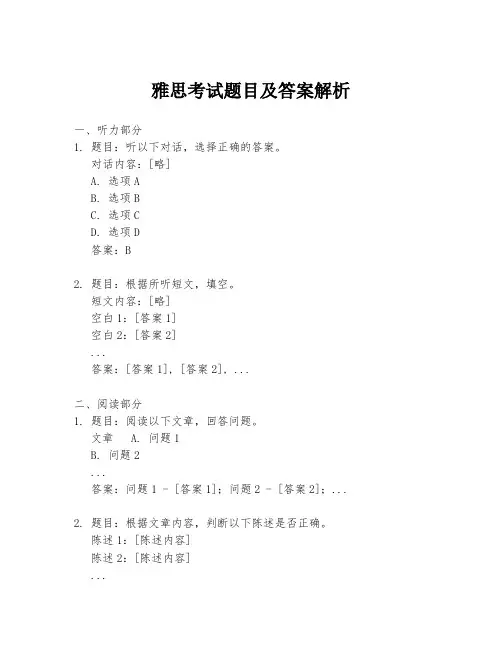
雅思考试题目及答案解析一、听力部分1. 题目:听以下对话,选择正确的答案。
对话内容:[略]A. 选项AB. 选项BC. 选项CD. 选项D答案:B2. 题目:根据所听短文,填空。
短文内容:[略]空白1:[答案1]空白2:[答案2]...答案:[答案1], [答案2], ...二、阅读部分1. 题目:阅读以下文章,回答问题。
文章 A. 问题1B. 问题2...答案:问题1 - [答案1];问题2 - [答案2];...2. 题目:根据文章内容,判断以下陈述是否正确。
陈述1:[陈述内容]陈述2:[陈述内容]...答案:陈述1 - True;陈述2 - False;...三、写作部分1. 题目:请根据以下图表,写一篇不少于150字的报告。
图表:[图表内容]答案示例:[略]2. 题目:请就以下问题写一篇议论文,不少于250字。
问题:[问题内容]答案示例:[略]四、口语部分1. 题目:请描述你最喜欢的一种食物。
答案示例:[略]2. 题目:请谈谈你对未来职业的期望。
答案示例:[略]答案解析:听力部分:1. 正确答案为B,因为对话中提到了相关信息,支持选项B。
阅读部分:1. 问题1的答案为[答案1],因为文章中明确提到了相关信息。
2. 陈述1为True,因为文章中提供了支持该陈述的证据。
写作部分:1. 报告应包含图表的主要特点和趋势,同时使用适当的词汇和语法结构。
2. 议论文应明确表达个人观点,使用逻辑清晰的论证和例证。
口语部分:1. 描述应包含食物的种类、口味、以及为什么喜欢该食物。
2. 期望应涉及职业选择的原因、目标以及实现目标的计划。
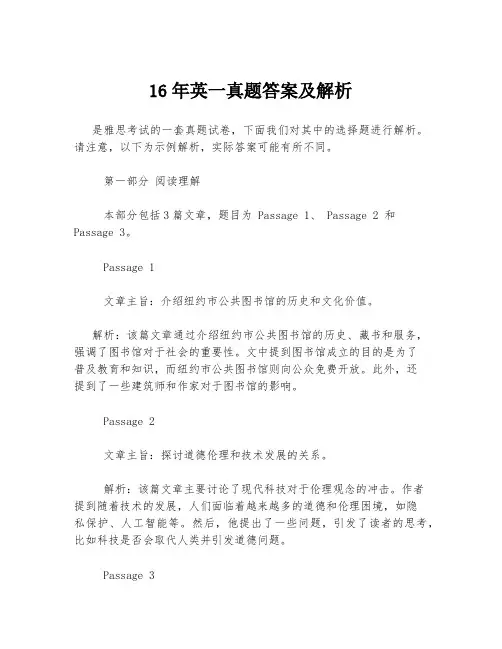
16年英一真题答案及解析是雅思考试的一套真题试卷,下面我们对其中的选择题进行解析。
请注意,以下为示例解析,实际答案可能有所不同。
第一部分阅读理解本部分包括3篇文章,题目为 Passage 1、 Passage 2 和Passage 3。
Passage 1文章主旨:介绍纽约市公共图书馆的历史和文化价值。
解析:该篇文章通过介绍纽约市公共图书馆的历史、藏书和服务,强调了图书馆对于社会的重要性。
文中提到图书馆成立的目的是为了普及教育和知识,而纽约市公共图书馆则向公众免费开放。
此外,还提到了一些建筑师和作家对于图书馆的影响。
Passage 2文章主旨:探讨道德伦理和技术发展的关系。
解析:该篇文章主要讨论了现代科技对于伦理观念的冲击。
作者提到随着技术的发展,人们面临着越来越多的道德和伦理困境,如隐私保护、人工智能等。
然后,他提出了一些问题,引发了读者的思考,比如科技是否会取代人类并引发道德问题。
Passage 3文章主旨:探讨电视对于儿童的影响。
解析:该篇文章主要讨论了电视对于儿童的负面影响。
作者指出,儿童过度依赖电视对于他们的身心发展不利,影响他们的思维能力、学习能力和社交能力。
此外,作者还提到了一些研究结果,以支持自己的观点。
第二部分完形填空本部分包括一篇文章,题目为 Passage 4。
文章主旨:讲述了一个女孩克服自卑情绪并实现个人成长的故事。
解析:该篇文章通过一个女孩的成长故事,强调了积极心态和个人成长的重要性。
女孩通过克服自卑情绪,努力学习和参加各种活动,最终取得了成功。
文章通过描写女孩的故事,传达了积极向上的价值观。
第三部分阅读理解本部分包括一篇文章,题目为 Passage 5。
文章主旨:介绍了一种新型的太阳能发电技术。
解析:该篇文章介绍了一种新型的太阳能发电技术,通过真空和化学反应产生能量。
文章描述了这种技术的工作原理、优势和应用前景。
作者认为这种技术有望替代传统的太阳能发电方法,成为一种更高效、更环保的能源。
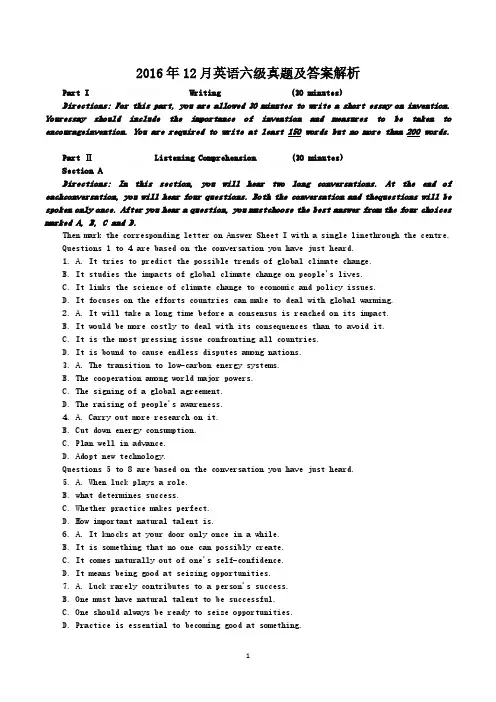
2016年12月英语六级真题及答案解析Part I Writing (30 minutes)Directions: For this part, you are allowed 30 minutes to write a short essay on invention. Youressay should include the importance of invention and measures to be taken to encourageinvention. You are required to write at least 150 words but no more than 200 words.Part Ⅱ Listening Comprehension (30 minutes)Section ADirections: In this section, you will hear two long conversations. At the end of eachconversation, you will hear four questions. Both the conversation and thequestions will be spoken only once. After you hear a question, you mustchoose the best answer from the four choices marked A, B, C and D.Then mark the corresponding letter on Answer Sheet I with a single linethrough the centre.Questions 1 to 4 are based on the conversation you have just heard.1. A. It tries to predict the possible trends of global climate change.B. It studies the impacts of global climate change on people's lives.C. It links the science of climate change to economic and policy issues.D. It focuses on the efforts countries can make to deal with global warming.2. A. It will take a long time before a consensus is reached on its impact.B. It would be more costly to deal with its consequences than to avoid it.C. It is the most pressing issue confronting all countries.D. It is bound to cause endless disputes among nations.3. A. The transition to low-carbon energy systems.B. The cooperation among world major powers.C. The signing of a global agreement.D. The raising of people's awareness.4. A. Carry out more research on it.B. Cut down energy consumption.C. Plan well in advance.D. Adopt new technology.Questions 5 to 8 are based on the conversation you have just heard.5. A. When luck plays a role.B. what determines success.C. Whether practice makes perfect.D. How important natural talent is.6. A. It knocks at your door only once in a while.B. It is something that no one can possibly create.C. It comes naturally out of one's self-confidence.D. It means being good at seizing opportunities.7. A. Luck rarely contributes to a person's success.B. One must have natural talent to be successful.C. One should always be ready to seize opportunities.D. Practice is essential to becoming good at something.8. A. Putting time and effort into fun things is profitable.B. People who love what they do care little about money.C. Being passionate about work can make one wealthy.D. People in need of money work hard automatically.Section BDirections: In this section, you will hear two passages. At the end of each passage, you will hearthree or four questions. Both the passage and the questions will be spoken only once.After you hear a question, you must choose the best answer from the four choices markedA, B, C and D. Then mark the corresponding letter on Answer Sheet 1 with asingle line through the centre.Questions 9 to 12 are based on the passage you have just heard.9. A. The stump of a giant tree.B. A huge piece of rock.C. The peak of a mountain.D. A tall chimney.10. A. Human activity.B. Wind and water.C. Chemical processes.D. Fire and fury.11. A. It is a historical monument.B. It was built in ancient times.C. It is Indians' sacred place for worship.D. It was created by supernatural powers.12. A. By sheltering them in a cave.B. By killing the attacking bears.C. By lifting them well above the ground.D. By taking them to the top of a mountain.Questions 13 to 15 are based on the passage you have just heard.13. A. They will buy something from the convenience stores.B. They will take advantage of the time to rest a while.C. They will have their vehicles washed or serviced.D. They will pick up some souvenirs or gift items.14. A. They can bring only temporary pleasures.B. They are meant for the extremely wealthy.C. They should be done away with altogether.D. They may eventually drive one to bankruptcy.15. A. A good way to socialize is to have daily lunch with one's colleagues.B. Retirement savings should come first in one's family budgeting.C. A vacation will be affordable if one saves 20 dollars a week.D. Small daily savings can make a big difference in one's life.Section CDirections: In this section, you will hear three recordings of lectures or talks followed by three orfour questions. The recordings will be played only once. After you hear a question, youmust choose the best answer from the four choices marked A, B, C and D. Thenmark the corresponding letter on Answer Sheet 1 with a single line through the centre.Questions 16 to 18 are based on the recording you have just heard.16. A. They should be done away with.B. They are necessary in our lives.C. They enrich our experience.D. They are harmful to health.17. A. They feel stressed out even without any challenges in life.B. They feel too overwhelmed to deal with life's problems.C. They are anxious to free themselves from life's troubles.D. They are exhausted even without doing any heavy work. ~18. A. They expand our mind.B. They prolong our lives.C. They narrow our focus.D.They lessen our burdensQuestions 19 to 22 are based on the recording you have just heard.19. A. It is not easily breakable.B. It came from a 3D printer.C. It represents the latest style.D. It was made by a fashion designer.20. A. When she had just graduated from her college.B. When she attended a conference in New York.C. When she was studying at a fashion design school.D. When she attended a fashion show nine months ago.21. A. It was difficult to print.B. It was hard to come by.C. It was hard and breakable.D. It was extremely expensive.22. A. It is the latest model of a 3D printer.B. It is a plastic widely used in 3D printing.C. It gives fashion designers room for imagination.D. It marks a breakthrough in printing material.Questions 23 to 25 are based on the recording you have just heard.23. A. They arise from the advances in technology.B. They have not been examined in detail so far.C. They are easy to solve with modern technology.D. They can't be solved without government support.24. A. It is attractive to entrepreneurs.B. It demands huge investment.C. It focuses on new products.D. It is intensely competitive.25. A.Cooperation with big companies.B. Recruiting more qualified staff.C. In-service training of IT personnel.D. Sharing of costs with each other.Part Ⅲ Reading Comprehension (40 minutes)Section ADirections: In this section, there is a passage with ten blanks. You are required to select one word foreach blank from a list of choices given in a word bank following the passage. Read thepassage through carefully before making your choices. Each choice in the bank isidentified by a letter. Please mark the corresponding letter for each item on Answer Sheet2 with a single line through the centre. You may not use any of the words in the bankmore than once.Questions 26 to 35 are based on the following passage.It is important that scientists be seen as normal people asking and answering important questions.Good, sound science depends on 26, experiments and reasoned methodologies. It requires awillingness to ask new questions and try new approaches. It requires one to take risks and experiencefailures. But good science also requires 27 understanding,clear explanation and concisepresentation.Our country needs more scientists who are willing to step out in the public 28 and offer theiropinions on important matters. We need more scientists who can explain what they are doing inlanguage that is 29 and understandable to the public. Those of us who are not scientists should alsobe prepared to support public engagement by scientists, and to 30 scientific knowledge into ourpublic communications.Too many people in this country, including some among our elected leadership, still do notunderstand how science works or why robust, long-range investments in research vitally matter. In the1960s, the United States 31 nearly 17% of discretionary (可酌情支配的) spending to research anddevelopment,32 decades of economic growth. By 2008, the figure had fallen into the single33 This occurs at a time when other nations have made significant gains in their own researchcapabilities.At the University of California (UC), we 34 ourselves not only on the quality of our research,but also on its contribution to improving our world. To 35 the development of science from the labbench to the market place, UC is investing our own money in our own good ideas.A. ArenaB. contextualC. ConvincingD. devotedE. DigitsF. hastenG. Hypotheses H. impairingI. Incorporate J. indefiniteK. Indulge L. inertiaM. Pride N. reapingO. WarrantSection BDirections: In this section, you are going to read a passage with ten statements attached to it. Eachstatement contains information given in one of the paragraphs. Identify the paragraphfrom which the information is derived. You may choose a paragraph more than once.Each paragraph is marked with a letter. Answer the questions by marking thecorresponding letter on Answer Sheet 2.Are We in an Innovation Lull?[A] Scan the highlights of this year's Consumer Electronics Show ( CES ), and you may get a slightfeeling of having seen them before. Many of the coolest gadgets this year are the same as thecoolest gadgets last year--or the year before, even. The booths are still exciting, and the demosare still just as crazy. It is still easy to be dazzled by the display of drones (无人机),3D printers,virtual reality goggles ( 眼镜) and more "smart" devices than you could ever hope to catalog.Upon reflection, however, it is equally easy to feel like you have seen it all before. And it is hardnot to think: Are we in an innovation lull ( 间歇期) ?[B] In some ways, the answer is yes. For years, smartphones, televisions, tablets, laptops anddesktops have made up a huge part of the market and driven innovation. But now these segmentsare looking at slower growth curves--or shrinking markets in some cases--as consumers are notas eager to spend money on new gadgets. Meanwhile, emerging technologies--the drones,3Dprinters and smart-home devices of the world--now seem a bit too old to be called "the next bigthing. "[C] Basically the tech industry seems to be in an awkward period now. "There is not any one-hitwonder, and there will not be one for years to come," said Gary Shapiro, president and chiefexecutive of the Consumer Technology Association (CTA). In his eyes, however, that doesn'tnecessarily mean that innovation has stopped. It has just grown up a little. "Many industries aregoing out of infancy and becoming adolescents," Shapiro said.[D] For instance, new technologies that are building upon existing technology have not found theirfooting well enough to appeal to a mass audience, because, in many cases, they need to workeffectively with other devices to realize their full appeal. Take the evolution of the smart home,for example. Companies are pushing it hard but make it almost overwhelming even to dip a toe inthe water for the average consumer, because there are so many compatibility issues to thinkabout. No average person wants to figure out whether their favorite calendar software works withtheir fridge or whether their washing machine and tablet get along. Having to install a different appfor each smart appliance in your home is annoying; it would be nicer if you could manageeverything together. And while you may forgive your smartphone an occasional fault, youprobably have less patience for error messages from your door lock.[E] Companies are promoting their own standards, and the market has not had time to choose awinner yet as this is still very new. Companies that have long focused on hardware now have tothink of ecosystems instead to give consumers practical solutions to their everyday problems."The dialogue is changing from what is technologically possible to what is technologicallymeaningful," said economist Shawn DuBravac. DuBravac works for CTA--which puts on theshow each year--and said that this shift to a search for solutions has been noticeable as heresearched his predictions for 2016.[F] "So much of what CES has been about is the cool. It is about the flashiness and the gadgets,"said John Curran, managing director of research at Accenture. "But over the last couple of years,and in this one in particular, we are starting to see companies shift from what is the largest screensize, the smallest form factor or the shiniest object and more into what all of these devices do thatis practical in a consumer's life. " Even the technology press conferences, which have been high-profile in the past and reached a level of drama and theatrics fitting for a Las Vegas stage, have adifferent bent to them. Rather than just dazzling with a high cool factor, there is a focus on thepractical. Fitbit, for example, released its first smartwatch Monday, selling with a clearpurpose--to improve your fitness--and promoting it as a "tool, not a toy. " Not only that, itsupports a number of platforms: Apple's iOS, Google's Android and Microsoft'sWindows phone.[G] That seems to be what consumers are demanding, after all. Consumers are becoming increasinglybored with what companies have to offer: A survey of 28,000 consumers in 28 countries releasedby Accenture found consumers are not as excited about technology as they once were. Forexample, when asked whether they would buy a new smartphone this year, only 48 percent saidyes--a six-point drop from 2015.[H] And when it comes to the hyper-connected super-smart world that technology firms are paintingfor us, it seems that consumers are growing more uneasy about handing over the massive amountsof consumer data needed to provide the personalized, customized solutions that companies needto improve their services. That could be another explanation for why companies seem to bestrengthening their talk of the practicality of their devices.[I] Companies have already won part of the battle, having driven tech into every part of our lives,tracking our steps and our very heartbeats. Yet the persistent question of " Why do I needthat?"--or, perhaps more tellingly, "Why do you need to know that?"--dogs the steps of manynew ventures. Only 13 percent of respondents said that they were interested in buying asmartwatch in 2016, for example--an increase of just one percent from the previous year despite ayear of high-profile launches. That is bad news for any firm that may hope that smartwatches canmake up ground for maturing smartphone and tablet markets. And the survey found flat demandfor fitness monitors, smart thermostats (恒温器) and connected home cameras, as well.[J] According to the survey, that lack of enthusiasm could stem from concerns about privacy andsecurity. Even among people who have bought connected devices of some kind,37 percent saidthat they are going to be more cautions about using these devices and services in the future. A full18 percent have even returned devices until they feel they can get safer guarantees against havingtheir sensitive information hacked.[K] That, too, explains the heavy Washington presence at this year's show, as these new technologiesintrude upon heavily regulated areas. In addition to many senior officials from the Federal Tradeand Federal Communications commissions, this year's list of policy makers also includesappearances from Transportation Secretary Anthony Foxx, to talk about smart cities, and FederalAviation Administration Administrator Michael Huerta, to talk about drones.[L] Curran, the Accenture analyst, said that increased government interest in the show makes senseas technology becomes a larger part of our lives. "There is an incompatibility in the rate at whichthese are advancing relative to the way we're digesting it," he said. "Technology is becomingbigger and more aspirational, and penetrating almost every aspect of our lives. We have tounderstand and think about the implications, and balance these great innovations with thepotential downsides they naturally carry with them. "36. Consumers are often hesitant to try smart-home devices because they are worried aboutcompatibility problems.37. This year's electronics show featured the presence of many officials from the federal government.38. The market demand for electronic devices is now either declining or not growing as fast as before.39. One analyst suggests it is necessary to accept both tlie positive and negative aspects of innovativeproducts.40. The Consumer Electronics Show in recent years has begun to focus more on the practicalvalue thanthe showiness of electronic devices.41. Fewer innovative products were found at this year's electronic products show.42. Consumers are becoming more worried about giving personal information to tech companies to getcustomized products and services.43. The Consumer Technology Association is the sponsor of the annual Consumer Electronics Show.44. Many consumers wonder about the necessity of having their fitness monitored.45. The electronic industry is maturing even though no wonder products hit the market.Section CDirections: There are 2 passages in this section. Each passage is followed by some questions orunfinished statements. For each of them there are four choices marked A, B, C andD. You should decide on the best choice and mark the corresponding letter on AnswerSheet 2 with a single line through the centre.Passage OneQuestions 46 to 50 are based on the following passage.The Paris climate agreement finalised in December last year heralded a new era for climate action.For the first time, the world's nations agreed to keep global warming well below 2℃.This is vital for climate-vulnerable nations. Fewer than 4% of countries are responsible for morethan half of the world's greenhouse gas emissions. In a study published in Nature Scientific Reports,we reveal just how deep this injustice runs.Developed nations such as Australia, the United States, Canada, and European countries areessentially climate "free-riders": causing the majority of the problems through high greenhouse gasemissions, while incurring few of the costs such as climate change's impact on food and water. In otherwords, a few countries are benefiting enormously from the consumption of fossil fuels, while at thesame time contributing disproportionately to the global burden of climate change.On the flip side, there are many "forced riders", who are suffering from the climate changeimpacts despite having scarcely contributed to the problem. Many of the world's most climatevulnerable countries, the majority of which are African or small island states, produce a very smallquantity of emissions. This is much like a non-smoker getting cancer from second-hand smoke, whilethe heavy smoker is fortunate enough to smoke in good health.The Paris agreement has been widely hailed as a positive step forward in addressing climate changefor all, although the details on addressing "climate justice" can be best described as sketchy.The goal of keeping global temperature rise "well below" 2~C is commendable but the emissions-reduction pledges submitted by countries leading up to the Paris talks are very unlikely to deliver onthis.More than $100 billion in funding has been put on the table for supporting developing nations toreduce emissions. However, the agreement specifies that there is no formal distinction betweendeveloped and developing nations in their responsibility to cut emissions, effectively ignoring historicalemissions. There is also very little detail on who will provide the funds or, importantly, who isresponsible for their provision. Securing these funds, and establishing who is responsible for raisingthem will also be vital for the future of climate-vulnerable countries.The most climate-vulnerable countries in the world have contributed very little to creatingtheglobal disease from which they now suffer the most. There must urgently be a meaningful mobilisationof the policies outlined in the agreement if we are to achieve national emissions reductions whilehelping the most vulnerable countries adapt to climate change.And it is clearly up to the current generation of leaders from high-emitting nations to decidewhether they want to be remembered as climate change tyrants or pioneers.46. The author is critical of the Paris climate agreement becauseA. it is unfair to those climate-vulnerable nationsB. it aims to keep temperature rise below 2℃ onlyC. it is beneficial to only fewer than 4% of countriesD. it burdens developed countries with the sole responsibility47. Why does the author call some developed countries climate "free-riders"?A. They needn't worry about the food and water they consume.B. They are better able to cope with the global climate change.C. They hardly pay anything for the problems they have caused.D. They are free from the greenhouse effects affecting "forced riders".48. Why does the author compare the "forced riders" to second-hand smokers?A. They have little responsibility for public health problems.B. They are vulnerable to unhealthy environmental conditions.C. They have to bear consequences they are not responsible for.D. They are unaware of the potential risks they are confronting.49. What does the author say about the $100 billion funding?A. It will motivate all nations to reduce carbon emissions.B. There is no final agreement on where it will come from.C. There is no clarification of how the money will be spent.D. It will effectively reduce greenhouse emissions worldwide.50. what urgent action must be taken to realise the Paris climate agreement?A. Encouraging high-emitting nations to take the initiative.B. Calling on all the nations concerned to make joint efforts.C. Pushing the current world leaders to come to a consensus.D. Putting in effect the policies in the agreement at once.Passage TwoQuestions 51 to 55 are based on the following passage.Teenagers at risk of depression, anxiety and suicide often wear their troubles like a neon (霓虹灯)sign. Their risky behaviors--drinking too much alcohol, using illegal drugs, smoking cigarettes andskipping school--can alert parents and teachers that serious problems are brewing.But a new study finds that there's another group of adolescents who are in nearly as much dangerof experiencing the same psychiatric symptoms: teens who use tons of media, don't get enough sleepand have a sedentary (不爱活动的) lifestyle.Of course, that may sound like a description of every teenager on the planet. But the study warnsthat it is teenagers who engage in all three of these practices in the extreme who are truly in jeopardy.Because their behaviors are not usually seen as a red flag, these young people have been dubbed the"invisible risk" group by the study's authors."In some ways they're at greater risk of falling through the cracks," says researcher VladimirCarli. "While most parents, teachers and clinicians would react to an adolescent using drugs or gettingdrunk, they may easily overlook teenagers who are engaging in inconspicuous behaviors."The study's authors surveyed 12,395 students and analyzed nine risk behaviors, including excessivealcohol use, illegal drug use, heavy smoking, high media use and truancy (逃学). Their aim was todetermine the relationship between these risk behaviors and mental health issues in teenagers.About 58% of the students demonstrated none or few of the risk behaviors. Some 13% scored highon all nine of the risk behaviors. And 29%, the "invisible risk" group, scored high on three inparticular: They spent five hours a day or more on electronic devices. They slept six hours a night orless. And they neglected "other healthy activities."The group that scored high on all nine of the risk behaviors was most likely to show symptoms ofdepression; in all, nearly 15% of this group reported being depressed, compared with just 4% of thelow-risk group. But the invisible group wasn't far behind the high-risk set, with more than 13% of themexhibiting depression.The findings caught Carli off guard. "We were very surprised," he says. "The high-risk group andlow-risk group are obvious. But this third group was not only unexpected, it was so distinct and solarge--nearly one third of our sample--that it became a key finding of the study. "Carli says that one of the most significant things about his study is that it provides new early-warning signs for parents, teachers and mental health-care providers. And early identification, supportand treatment for mental health issues, he says, are the best ways to keep them from turning into full-blown disorders.51. What does the author mean by saying "Teenagers at risk of depression, anxiety and suicide oftenwear their troubles like a neon sign" (Lines 1 - 2, Para.1 ) ?A. Mental problems can now be found in large numbers of teenagers.B. Teenagers' mental problems are getting more and more attention.C. Teenagers' mental problems are often too conspicuous not to be observed.D. Depression and anxiety are the most common symptoms of mental problems.52. What is the finding of the new study?A. Teenagers' lifestyles have changed greatly in recent years.B. Many teenagers resort to drugs or alcohol for mental relief.C. Teenagers experiencing psychological problems tend to use a lot of media.D. Many hitherto unobserved youngsters may have psychological problems.53. Why do the researchers refer to teens who use tons of media, don't get enough sleep and have asedentary lifestyle as the "invisible risk" group?A. Their behaviors can be an invisible threat to society.B. Their behaviors do not constitute a warning signal.C. Their behaviors do not tend towards mental problems.D. Their behaviors can be found in almost all teenagers on earth.54. What does the new study find about the invisible group?A. They are almost as liable to depression as the high-risk group.B. They suffer from depression without showing any symptoms.C. They do not often demonstrate risky behaviors as their peers.D. They do not attract the media attention the high-risk group does.55. What is the significance of Vladimir Carli's study?A. It offers a new treatment for psychological problems among teenagers.B. It provides new early-warning signals for identifying teens in trouble.C. It may have found an ideal way to handle teenagers with behavioral problems.D. It sheds new light on how unhealthy behaviors trigger mental health problems.Part Ⅳ Translation (30 minutes)Directions: For this part, you are allowed 30 minutes to translate a passage from Chinese intoEnglish. You should write your answer on Answer Sheet 2.随着生活水平的提高,度假在中国人生活中的作用越来越重要。
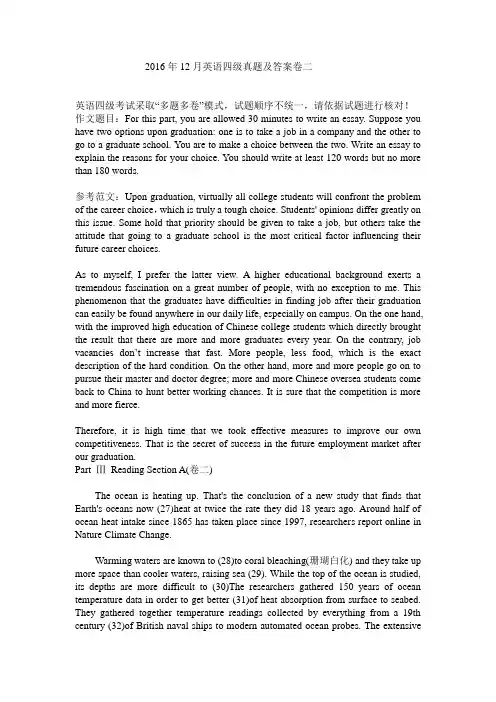
2016年12月英语四级真题及答案卷二英语四级考试采取“多题多卷”模式,试题顺序不统一,请依据试题进行核对!作文题目:For this part, you are allowed 30 minutes to write an essay. Suppose you have two options upon graduation: one is to take a job in a company and the other to go to a graduate school. You are to make a choice between the two. Write an essay to explain the reasons for your choice. You should write at least 120 words but no more than 180 words.参考范文:Upon graduation, virtually all college students will confront the problem of the career choice,which is truly a tough choice. Students' opinions differ greatly on this issue. Some hold that priority should be given to take a job, but others take the attitude that going to a graduate school is the most critical factor influencing their future career choices.As to myself, I prefer the latter view. A higher educational background exerts a tremendous fascination on a great number of people, with no exception to me. This phenomenon that the graduates have difficulties in finding job after their graduation can easily be found anywhere in our daily life, especially on campus. On the one hand, with the improved high education of Chinese college students which directly brought the result that there are more and more graduates every year. On the contrary, job vac ancies don’t increase that fast. More people, less food, which is the exact description of the hard condition. On the other hand, more and more people go on to pursue their master and doctor degree; more and more Chinese oversea students come back to China to hunt better working chances. It is sure that the competition is more and more fierce.Therefore, it is high time that we took effective measures to improve our own competitiveness. That is the secret of success in the future employment market after our graduation.Part ⅢReading Section A(卷二)The ocean is heating up. That's the conclusion of a new study that finds that Earth's oceans now (27)heat at twice the rate they did 18 years ago. Around half of ocean heat intake since 1865 has taken place since 1997, researchers report online in Nature Climate Change.Warming waters are known to (28)to coral bleaching(珊瑚白化) and they take up more space than cooler waters, raising sea (29). While the top of the ocean is studied, its depths are more difficult to (30)The researchers gathered 150 years of ocean temperature data in order to get better (31)of heat absorption from surface to seabed. They gathered together temperature readings collected by everything from a 19th century (32)of British naval ships to modern automated ocean probes. The extensivedata sources, (33)with computer simulations(计算机模拟), created a timeline of ocean temperature changes, including cooling from volcanic outbreaks and warming from fossil fuel (34).About 35 percent of the heat taken in by the oceans during the industrial era now residents at a (35)of more than 700 meters, the researchers found. They say they're unsure(36)whether the deep-sea warming canceled out warming at the sea's surface.A absorbB combinedC contributeD depthE emissionF.exploreG exploreH.floorI.heightsJ.indifferentK levelL.mixedM pictureN unsureO voyage参考答案:(26)A absorb(27)C contribute(28)K level(29)G explore(30)M picture(31)O voyage(32)B combined(33)E emission(34)D depth(35)N unsure参考解析文章第一句讲到海洋正在升温,不难推断出第26题应该是选absorb,absorb 为吸收的意思。
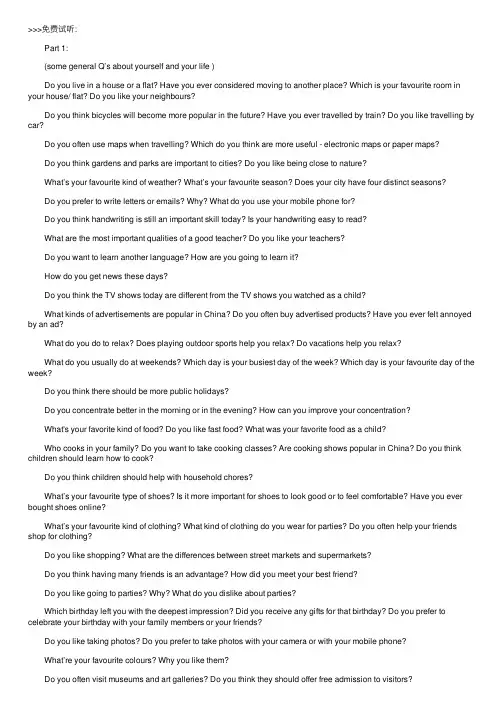
>>>免费试听: Part 1: (some general Q’s about yourself and your life ) Do you live in a house or a flat? Have you ever considered moving to another place? Which is your favourite room in your house/ flat? Do you like your neighbours? Do you think bicycles will become more popular in the future? Have you ever travelled by train? Do you like travelling by car? Do you often use maps when travelling? Which do you think are more useful - electronic maps or paper maps? Do you think gardens and parks are important to cities? Do you like being close to nature? What’s your favourite kind of weather? What’s your favourite season? Does your city have four distinct seasons? Do you prefer to write letters or emails? Why? What do you use your mobile phone for? Do you think handwriting is still an important skill today? Is your handwriting easy to read? What are the most important qualities of a good teacher? Do you like your teachers? Do you want to learn another language? How are you going to learn it? How do you get news these days? Do you think the TV shows today are different from the TV shows you watched as a child? What kinds of advertisements are popular in China? Do you often buy advertised products? Have you ever felt annoyed by an ad? What do you do to relax? Does playing outdoor sports help you relax? Do vacations help you relax? What do you usually do at weekends? Which day is your busiest day of the week? Which day is your favourite day of the week? Do you think there should be more public holidays? Do you concentrate better in the morning or in the evening? How can you improve your concentration? What's your favorite kind of food? Do you like fast food? What was your favorite food as a child? Who cooks in your family? Do you want to take cooking classes? Are cooking shows popular in China? Do you think children should learn how to cook? Do you think children should help with household chores? What’s your favourite type of shoes? Is it more important for shoes to look good or to feel comfortable? Have you ever bought shoes online? What’s your favourite kind of clothing? What kind of clothing do you wear for parties? Do you often help your friends shop for clothing? Do you like shopping? What are the differences between street markets and supermarkets? Do you think having many friends is an advantage? How did you meet your best friend? Do you like going to parties? Why? What do you dislike about parties? Which birthday left you with the deepest impression? Did you receive any gifts for that birthday? Do you prefer to celebrate your birthday with your family members or your friends? Do you like taking photos? Do you prefer to take photos with your camera or with your mobile phone? What’re your favourite colours? Why you like them? Do you often visit museums and art galleries? Do you think they should offer free admission to visitors? What’s your favourite kind of music? Do you play any instruments? What games did you like to play when you were a child? What games do children play these days?【新东⽅雅思课程推荐】新版雅思讲义更轻松更容易>>⽬标:7分⽬标:6.5分⽬标:6分。
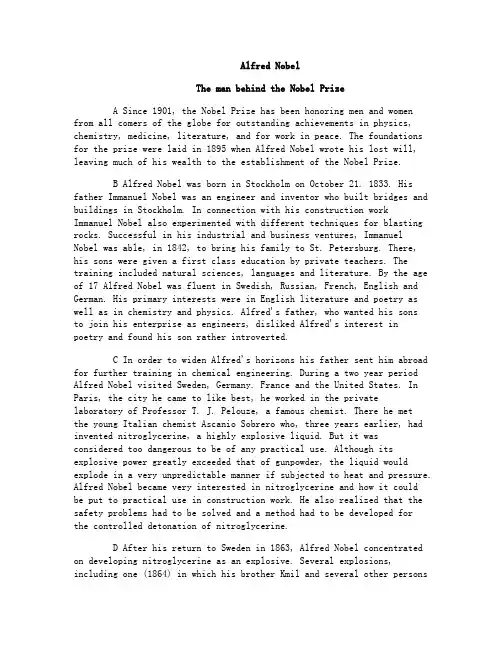
Alfred NobelThe man behind the Nobel PrizeA Since 1901, the Nobel Prize has been honoring men and women from all comers of the globe for outstanding achievements in physics, chemistry, medicine, literature, and for work in peace. The foundations for the prize were laid in 1895 when Alfred Nobel wrote his lost will, leaving much of his wealth to the establishment of the Nobel Prize.B Alfred Nobel was born in Stockholm on October 21. 1833. His father Immanuel Nobel was an engineer and inventor who built bridges and buildings in Stockholm. In connection with his construction work Immanuel Nobel also experimented with different techniques for blasting rocks. Successful in his industrial and business ventures, ImmanuelNobel was able, in 1842, to bring his family to St. Petersburg. There, his sons were given a first class education by private teachers. The training included natural sciences, languages and literature. By the age of 17 Alfred Nobel was fluent in Swedish, Russian, French, English and German. His primary interests were in English literature and poetry as well as in chemistry and physics. Alfred's father, who wanted his sonsto join his enterprise as engineers, disliked Alfred's interest inpoetry and found his son rather introverted.C In order to widen Alfred's horizons his father sent him abroad for further training in chemical engineering. During a two year period Alfred Nobel visited Sweden, Germany. France and the United States. In Paris, the city he came to like best, he worked in the privatelaboratory of Professor T. J. Pelouze, a famous chemist. There he metthe young Italian chemist Ascanio Sobrero who, three years earlier, had invented nitroglycerine, a highly explosive liquid. But it was considered too dangerous to be of any practical use. Although its explosive power greatly exceeded that of gunpowder, the liquid would explode in a very unpredictable manner if subjected to heat and pressure. Alfred Nobel became very interested in nitroglycerine and how it couldbe put to practical use in construction work. He also realized that the safety problems had to be solved and a method had to be developed forthe controlled detonation of nitroglycerine.D After his return to Sweden in 1863, Alfred Nobel concentrated on developing nitroglycerine as an explosive. Several explosions, including one (1864) in which his brother Kmil and several other personswere killed, convinced the authorities that nitroglycerine production was exceedingly dangerous. They forbade further experimentation with nitroglycerine within the Stockholm city limits and Alfred Nobel had to move his experimentation to a barge anchored on Lake Malaren. Alfred was not discouraged and in 1864 he was able to start mass production of nitroglycerine. To make the handling of nitroglycerine safer Alfred Nobel experimented with different additives. He soon found that mixing nitroglycerine with kieselguhr would turn the liquid into a paste which could be shaped into rods of a size and form suitable for insertion into drilling holes. In 1867 he patented this material under die name of dynamite. To be able to detonate the dynamite rods he also invented a detonator (blasting cap) which could be ignited by lighting a fuse. These inventions were made at the same time as the pneumatic drill came into general use. Together these inventions drastically reduced the cost of blasting rock, drilling tunnels, building canals and many other forms of construction work.E The market for dynamite and detonating caps grew very rapidly and Alfred Nobel also proved himself to be a very skillful entrepreneur and businessman.Over the years he founded factories and laboratories in some 90 different places in more than 20 countries. Although he lived in Paris much of his life he was constantly traveling. When he was not traveling or engaging in business activities Nobel himself worked intensively in his various laboratories, first in Stockholm and later in other places. He focused on the development of explosives technology as well as other chemical inventions, including such materials as synthetic rubber and leather, artificial silk, etc. By the time of his death in 18% he had 355 patents.F Intensive work and travel did not leave much time for aprivate life. At the age of 43 he was feeling like an old man. At this time he advertised in a newspaper"Wealthy, highly-educated elder gentleman seeks lady of mature age, versed in languages, as secretary and supervisor of household." The most qualified applicant turned out to be an Austrian woman. Countess Bertha Kinsky. After working a very short time for Nobel she decided to return to Austria to marry Count Arthur von Suttner. In spite of this Alfred Nobel and Bertha von Suttner remained friends and kept writing letters to each other for decades. Over the years Bertha von Suttner became increasingly critical of the arms race. She wrote a famous book, Lay Down Your Arms and became a prominent figure in the peace movement. No doubt this influenced Alfred Nobel when he wrote his final will which was to include a Prize forpersons or organizations who promote peace. Several years after thedeath of Alfred Nobel, the Norwegian Storting (Parliament) decided to award the 1905 Nobel Peace Prize to Bertha von Suttner.G Alfred Nobel died in San Remo, Italy, on December 10, 1896. When his will was opened it came as a surprise that his fortune was tobe used for Prizes in Physics, Chemistry. Physiology or Medicine, Literature and Peace. The executors of his will were two young engineers, Ragnar Sohlman and Rudolf Lilljequist. They set about forming the Nobel Foundation as an organization to take care of the financial assets left by Nobel for this purpose and to coordinate the work of the Prize-Awarding Institutions. This was not without its difficulties since the will was contested by relatives and questioned by authorities in various countries.H Alfred Nobel's greatness lay in his ability to combine the penetrating mind of the scientist and inventor with the forward-looking dynamism of the industrialist. Nobel was very interested in social and peace-related issues and held what were considered radical views in his era. He had a great interest in literature and wrote his own poetry and dramatic works. The Nobel Prizes became an extension d a fulfillment of his lifetime interests.Questions 1-6Do the following statements agree with the information given in Reading Passage 1?In boxes 1-6 on your answer sheet, writeTRUE if the statement is trueFALSE if the statement is falseNOT GIVEN if the information is not given in the passage1 The first Nobel Prize was awarded in 1895.2 Nobel's father wanted his son to have better education than what he had had.3 Nobel was an unsuccessful businessman.4 Bertha von Suttner was selected by Nobel himself for the first peace prize.5 The Nobel Foundation was established after the death of Nobel6 Nobel's social involvement was uncommon in the 1800’s.Questions 7-13Complete the notes below using NO MORE THAN TWO WORDS from the passage.Write your answers in boxes 7-13 on your answer sheet.Table 1Education:Having accumulated a great fortune in his business, Nobel's father determined to give his son the best education and sent him abroad to be trained in 7 During Nobel's study in Paris, he worked in a private laboratory, where he came in contact with a young Scientist (engineer) 8 and his invention nitroglycerine, a more powerful explosive than 9Table 2Benefits in construction works:Nobel became really interested in this new explosive and experimented on it. But nitroglycerine was too dangerous and was banned for experiments within the city of 10 So Nobel had to move his experiments to a lake. To make nitroglycerine easily usable, Nobel invented dynamite along with 11 while in the meantime 12became popular, all of which dramatically lowered the 13 of construction works.文章题目:Alfred NobelThe man behind the Nobel Prize篇章结构试题分析题目类型:参考答案:。
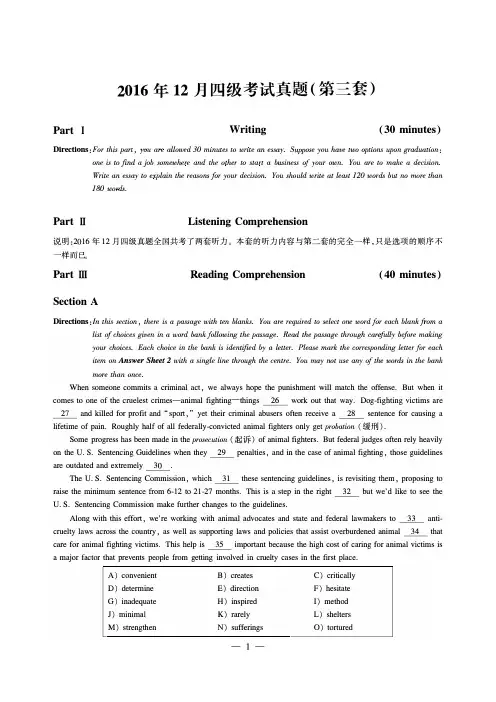
2016年12月大学英语四级考试答案与解析(第3套)Part I Writing【范文】In the past two years of my college life, I have never ceased to think what kind of work I shall take up upon graduation. Although my ideas are not consistent, I have now decided to start a business of my own as my lifelong career.A variety of factors have led me to make this decision over other more lucrative ones. To begin with, running my own business means freedom and independence. As a person having my own business, it can fully express myself and make my own decisions, a privilege not everyone can have, even those with highly-paid positions. More importantly, I like starting my own business in that it combines with interest and work. A person can only devote himself to doing the best when he is really interested in one thing. What's more, start a business of my own offers a certain peace of mind. No more rushing to catch a morning bus, no more worries about when I will get fired, no more anxious to please a boss.I do not want to miss this entrepreneurial era, and nothing, not even a big salary, can equal for the satisfaction of being your own boss and a gentle peace of life.Section A当有人犯罪时,我们总希望惩罚与罪行相当。
雅思(听力)历年真题试卷汇编30(题后含答案及解析) 题型有:1. Listening ModuleListening Module (30 minutes & 10 minutes transfer time)听力原文:AGENT: Hello, Elite Travel, this is Emily speaking, how may I assist you today? CUSTOMER: Hi, I have a group visit to plan, and I wonder whether you could help me decide on which hotel to book. I have narrowed it down to either the Winchester, the Royal Hotel, or the Star Hotel. I am wondering if you have a recommendation. AGENT: I would be happy to help! Those three are excellent choices. If everyone is booking hotel rooms independently, an easy way to do it is online booking. The Star Hotel offers online bookings at no additional charge. CUSTOMER: It sounds fine! AGENT: Yeah, and you can even book the gorgeous [1]sea view rooms if you act quickly. CUSTOMER: Hm, I will consider that. It would be great since we are mostly first-time visitors to the area to get a nice view of the water. Now, are there handicap accessible rooms? AGENT: [2]Yes, all three options have access for the physically disabled.CUSTOMER: Great. I should also mention that we will be on a tight schedule, so we won’t have much time to go out for meals. Which of these hotels serve food? AGENT: There is a limited continental breakfast menu at the Star and at the Winchester. [3]For a full restaurant and room service, the Royal Hotel is your best bet. CUSTOMER: Oh wonderful! Could you tell me more about the restaurant? AGENT: Absolutely. In the morning there is a gourmet buffet or a la carte item, and after 11 a.m. lunch is served in the dining room. [4]Dinners are in a nice, low-key but high quality setting in the hotel’s private dining room and Fridays feature the house jazz band. CUSTOMER: How lovely! Is there a group discount? AGENT: No, sorry. Not at the Royal hotel. Let me check on the others, though. Could I place you on hold for just a second? CUSTOMER: Sure, thanks. AGENT: [5]It looks like there is one at the Winchester - 15% off when you book 8 or more rooms. CUSTOMER: Really? Sold! We’ll book at the Winchester. Wait - is it suitable for children though? We’ll have a few little ones in our group, and it would be great to have a way to keep them occupied. AGENT: Yes. In fact, [6]it has a play place that kids just love, with slides, and swings and everything. Definitely a good hotel to bring the kids. CUSTOMER: Okay, great.CUSTOMER: So now I know where we’ll be staying, what next? Should I go ahead and book transportation and assign rooms and everything? AGENT: Well, for now, there are only a few things for you to take care of. We will hold a block of rooms for you as soon as you send a [7]deposit. I recommend booking as soon as possible, so you probably want to send the [8]invitations as soon as you know how many rooms to hold. CUSTOMER: Oh, right. Okay, I’ll send the invitations and put down the deposit. Is there anything else I should take care of? AGENT: Great! And don’t worry about this now, but sometime before you arrive do let us know if you’ll be requiring our [9]transport service to and from the airport. CUSTOMER: I’ll make sure to let you know. Does that incur a service charge? Orperhaps a tip, or some presents to show our gratitude for the personal car service? AGENT: Oh, don’t worry about it. It is a free service, so if you would like to tip you are welcome to do so, but hotel drivers do not accept [10]gifts. CUSTOMER: Thanks for your help! AGENT: My pleasure. Enjoy your stay at the Winchester!Which hotels have the following facilities?Write the correct letter, A, B, C, or D next to questions 1-6.A Royal HotelB Star HotelC Winchester HotelD All Three HotelsExample: Online booking B1.Sea view正确答案:B解析:注意Example处答案选项为B Star Hotel,据此大胆猜测:接下来谈论的很可能还是这家旅馆,当然也可能会转移新的话题。
2016年12月大学英语四级真题试卷(二)(题后含答案及解析)题型有:1. Writing 2. Listening Comprehension 3. Reading Comprehension 4. TranslationPart I Writing1.For this part, you are allowed 30 minutes to write an essay. Suppose you have two options upon graduation: one is to take a job in a company and the other to go to a graduate school. You are to make a choice between the two. Write an essay to explain the reasons for your choice. You should write at least 120 words but no more than 180 words.正确答案:Going to Graduate School Is a Better Choice If given two options after graduation, that is, to take a job in a company or to go to a graduate school, I’d prefer the latter. First and foremost, it is widely acknowledged that a higher level of education means better payments and more opportunities in the future in China. Therefore, I think another two or three years’investment in graduate education must be worthwhile in the long run. Secondly, I love my major and have a strong desire to further my study so as to deeply explore some academic issues in this field. Finally, the job market for undergraduate students is too competitive for average students like me to find a satisfying job. Thus, it would be a better choice if I could obtain a master’s degree. Considering the three reasons listed above, I would choose to go to a graduate school after graduation to earn a better future.Part II Listening ComprehensionSection A听力原文:New York State plans to shut off the thundering waters of Niagara Falls—again. At least, the American side of the falls. This “once in a lifetime” event actually may take place twice in some folks’ lives.(1)The New York State parks system wants to turn off the falls on the American side sometime in the next two to three years to replace two 115-year-old stone bridges that allow pedestrians, park vehicles and utilities access to Goat Island. The American side of the falls were shut off in 1969 to study the buildup of rock at the base of the falls. When that happened, people came from all over the world to see the falls turned off. People are curious by nature. They want to see what’s underneath. In fact, those who first came to have a look did see something.(2)They found millions of coins on the bottom.Questions 1 and 2 are based on the news report you have just heard.1. Why does New York State want to turn off Niagara Falls?2. What did people find when Niagara Falls were shut off in 1969?2.A.To satisfy the curiosity of tourists.B.To replace two old stone bridges.C.To enable tourists to visit Goat Island.D.To improve utility services in the state.正确答案:B解析:新闻中提到,纽约州公园系统想在未来的两三年内关闭美国境内的尼亚加拉大瀑布,以更换行人、公园车辆和设备通往山羊岛的两座石桥,这两座石桥距今已有115年的历史了。
12月10日雅思写作考试真题2016年12月10日雅思写作考试真题Some people think they have the right to use as much fresh water as they want, while others believe governments should tightly control the use of fresh water as it is a limited resource. Discuss both views and give your opinion.雅思作文范文【1】Fresh water is a necessity in human’s daily life but how to use it varies in different societies. Some people take unlimited water consumption for granted, but others think that it is governments’ obligation to control fresh water as it is limited.It is true that most residents in developed countries and coastal nations do not need to worry about the shortage of fresh water. Sophisticated infrastructures and sufficient precipitation can guarantee sufficient water supply. The price that these occupants need to pay is water bills and they can use as much water as they want if only they can afford it. Thus, it is undoubted that some of them hold the opinion that they can utilize the resource freely if they want.While many other people do not need to concern about water consumption, it is also a fact that a large number of inhabitants in many developing countries have no access to clean water because of its scarcity. In those countries, natural environment and climate like droughts have a negative effect on water supply. What is worse, the poor situation makes water even more precious. If people use as much water as they want in those areas, it can almost be sure that water supply will fail to meet some people’s daily need. Therefor e, it is reasonable that local officials limit the individual water use and people who waste it will be punished.In my opinion, fresh water should not be used without any restriction. Water supply depends on heavily on natural environment that it can be regarded as limited resource in some countries. Water conservation, whether it is advocated by government or not, is what people should insist on.主旨句:In my opinion, fresh water should not be used without any restriction.雅思作文范文【2】When it comes to the issue about the use of fresh water, some people argue that they are entitled to consume fresh water without limitation, but others believe that the use of fresh water should be controlled by governments strictly.On one hand, individuals have the right to use fresh water as long as they pay for it. Fresh water is also a kind of commodity. When a person paid money for fresh water, theoretically, this person possesses the property right of fresh water paid and such a property right is guaranteed by laws in most countries. Therefore, if citizens are able to afford the price of fresh water, their right of using water should be protected.On the other hand, since fresh water is an infinite resource, excessive use of fresh water needs to be prohibited by the authorities. It is acknowledged that fresh water accounts for less than 1% of total water resources on the earth and many regions lack fresh water currently. If governments do not punish people who waste such a precious resource, in the future, fresh water may be exhausted and human beings may notfind the alternative so quickly. Thus, in order to maintain the environmental sustainability, city councils need to regulate citizens’ behavior.From my own perspective, it is unrealistic and immoral for individuals to use water excessively, but residents may also suffer if governments strictly limit the use of fresh water. A compromise may be that governments do not utilize political power, but economic measuresto raise the public’s environmental awarenes s. To be more specific, if individuals or enterprises consume too much water, the price of fresh water will be much higher for them, which aims to remind them of the necessity of recycling water. For ordinary citizens, if they just use water within a normal range, there is no need to impose extra fines on them.主旨句:From my own perspective, it is unrealistic and immoral for individuals to use water excessively, but residents may also suffer if governments strictly limit the use of fresh water.雅思作文范文【3】Fresh water is considered as one of the most valuable resources in this planet, but its consumption is huge due to the growing population and the increasing demand in agriculture and industry. As water shortage is becoming increasingly severe in many parts of the world, it is suggested that the government should control the amount of water use.Considering the deteriorating water crisis,it is urgent to reduce water consumption and conserve fresh water resource. For some reasons, wasting water is common in farms, factories and households. Some people believe the government has the obligation to intervene and take steps to combat the situation. For instance, if the authorities could raise the water price, or set the maximum quantity of water consumption in factors, or forcibly promote water-saving technology in agriculture sector, the water use is expected to decline.However, some people object to the government's intervention and believe citizens have the right to use water as they want. The main concern is that the limitation of water use may lower the living standard and cause inconveniences in daily lives,In some cases, it could lead to poor sanitary condition and the spread of diseases.The downsides of the government's policy should also be noted. For example,raising water price seems to be an effective solution, but rich people may not care about it.Instead,it would only hurt the interests of the general public.My View is that it is justified for the government to take necessary measures to tackle the water crisis, Perhaps the first step is to raise people's awareness of water conservation, making them realize the urgency of this task .With the support from the general public, the government's policies would be better implemented.主旨句:My View is that it is justified for the government to take necessary measures to tackle the water crisis, Perhaps the first step isto raise people's awareness of water conservation, making them realize the urgency of this task .With the support from the general public, the government's policies would be better implemented.。
第1章雅思(IELTS)考试指南1.1雅思考试简介1.雅思考试性质雅思(IELTS)考试,全称International English Language Testing(国际英语语言测试系统),为剑桥大学考试委员会外语考试部、英国文化协会和IDP教育集团共有,而在中国的雅思考试主要由英国文化协会负责。
该考试以其特有的可靠性和权威性,目前已得到全球多所院校机构、政府部门和职业机构的认可。
该项考试是为打算在交流语言为英语的国家或地区进行学习或工作的人们所设置的英语语言水平考试。
2.雅思考试分类和目的雅思考试分为学术类(Academic)和培训类(General Training)两种类型,学术类在于测试考生是否有在英语环境中就读高校本科或研究生课程的语言能力;普通培训类适用计划移民、出国工作或申请国外非学术培训、中学课程的考生,侧重点在于评估考生是否掌握足够英语技能在英语国家生活的能力。
1.2雅思考试试题分析及解题技巧雅思考试是对考生听说读写四项英语交流能力的测试,测试内容包括听力、阅读、写作和口语共四部分。
雅思考试的试卷结构如下所示:雅思学术类和培训类考试总时间均为2小时24分钟,其中对于听力和口语部分,学术类和培训类考试的测试内容完全相同;而阅读部分和写作部分则使用不同的试题。
需要注意的是除口语外,听力、阅读和写作均在同一天进行测试。
1.雅思听力试题分析及解题技巧雅思听力部分主要是对考生在英语语境中,对实际使用中英语的适应和理解能力的测试。
雅思听力由四部分构成,难度会依次递增,第一部分为两人对话,第二部分通常为一段独白(对话的形式较少出现),第三部分为多人对话(最多四人),第四部分又是一段独白。
其中前两部分内容涉及社会课题,而后两部分与与教育或培训课题相关。
听力时间为30分钟,录音结束后会有10分钟誊写答案的时间,需注意雅思听力中的录音只放一遍。
雅思听力的测试形式多样,其中历年考试中考过的题型达到十几种,主要包括选择题、简答题、完成句子题、完成笔记/表格/图表/摘要/流程图/时间表题、为图表/设计图/地图做标记题、分类和配对题等。
2016年12月大学英语六级考试真题答案与详解(第1套)Part I Writing审题思路本篇写作话题invention(发明)是考生日常生活中非常熟悉的话题,因此写起来并不困难。
根据写作要求,范文应分三段展开论述,且写作重点应该放在阐述发明的重要性和为鼓励发明应采取的措施两方面。
众所周知,发明对于推动社会进步具有重要意义,若要鼓励发明,首先应该使公众具备创造意识,了解发明的重要性,其次对发明者应给予奖励以鼓励其将创造精神发扬光大。
写作提纲一、引出话题并阐明发明的重要性1. 由古今生活的对比引出发明的重要性(modern life, ancient life, great importance, contributes to, advancement, society)2. 引用爱迪生发明灯泡的实例论证发明的重要性(examples, illustrate, Edison, light bulb, a life as the blind)二、为鼓励发明应采取的措施1. 社会传播媒介和宣传部门向公众宣扬发明的重要性(social media, publicity department, inform, importance of invention)2. 相关部门应该对发明者进行奖励(authorities, favorable regulations, encourage invention, giving premiums, issuing patent certificate)三、得出结论1. 引用名言强调发明的重要性(Invention, spirit, human being's progress)2. 要求我们不能低估发明的重要性,并号召大家发挥自己的创造精神(At no time should we underestimate the power of invention, make your own invention)高分范文My View on Invention①Drawing a comparison between modern life and ancient life, we cannot imagine what life will be like now without invention. ②Invention must be attached great importance to, as it is invention that contributes to the advancement of our society. ③There are several examples which can be cited to illustrate this concept. ④I can think of no better illustration than the following one. ⑤If Edison hadn't invented the light bulb, we would have lived a life as the blind in the night.⑥Given that invention plays such an essential role in our life, what can we do to cultivate this precious spirit? ⑦For one thing, it is advisable for the social media and publicity department to vigorously inform the public of the importance of invention. ⑧For another, the relevant authorities should set up favorable regulations to encourage invention. ⑨For example, they can set up the practice of giving premiums or issuing patent certificate to inventors.⑩Finally, I want to use the following saying as our mutual encouragement, “Invention is the spirit of human being's progress.”11 At no time should we underestimate the power of invention. 12 Therefore, when an idea comes to your mind, just make your own invention.精彩点评①②由古今生活的对比强调发明的重要性。
2016年12月10日雅思考试真题及答案解析12月10日雅思听力
S1 order restaurant
S2 garbage recycle
S3 oil resources
S4robots
12月10日雅思阅读
第一篇是interpretation
第二篇是animal
第三篇电报发明者
A类小作文饼图,对比的是the number of people per household;
大作文:一些人认为每个人都有权利可以随意使用干净水,另一些人认为政府应该干涉限制水资源的使用,因为水资源是有限的。
北京北京语言大学P1: 家庭住什么房子,家里窗户能看到什么,经常陪父母么,一起的时候都干嘛P2: 一个想短期打工的国家P3: 年轻人去国外工作好吗?一般都干什么?为什么好多人想去跨国企业
首都经济贸易大学IELTS考试中心RM5 P1: 家乡,报纸和杂志,广告P2: 描述一项保持健康的活动P3: 你们家乡有没有足够的设施供人们锻炼?怎么看待青少年过度肥胖?怎么做?
天津天津外国语大学part1 do you love your hometown, will you go back to your hometown, house or flat, what can you see through the window; part2 sth made you laugh; part3 男女觉得有意思的事情是不是不一样,不同年龄的人看喜剧是不是不同
辽宁沈阳师范大学P1:study/ will do / visitor in home P2: a small business P3: 大公司小公司MBA课程管理技能
黑龙江哈尔滨工业大学IELTS考试中心01 P1: 念书还是工作,学的科目有什么,你喜欢你学的专业吗,你小时候做的户外运动有什么,你认为孩子应该做户外运动吗,你喜欢唱歌吗,你小时候唱歌吗P2:你和你家里人在一起共度的时光P3: 你喜欢老物件吗,你认为
年轻人和老人喜欢的老物件有区别吗
黑龙江大学02 P1: 学生还是工作,花,喜欢一个人还是团体工作P2: good new 最近卡到,在哪,什么时候看到的,什么感觉对于这个新闻P3: 公众喜欢什么样的新闻,传播一个新闻需要什么
吉林吉林大学P1: 专业,艺术P2: 让你生气的事情P3: 是否应该表现自己强烈的感觉,后面都是free style
湖北武昌实验part1 家乡,家乡让你印象深刻的地方; part2 describe a small business you would like to own ; part3 愿意做自己的老板吗,发展在大公司好还是小公司,愿意去大公司还是小公司
武昌实验part1 major,why this major, 跟别人学习还是自己学习,outdoor activity,多久做一次活动,去兴趣班吗,参观过画廊吗; part2 有时间想学的课程是什么; part3 大学会为学生们提供别的课程吗,大学应该设置其他类课程吗,找工作时,专业知识重要还是工作经验重要
福建福建师范大学P1:工作,空闲时间跟家人做什么,怎么跟家人过周末P2: 有趣的歌P3: 关于歌的问题
广东广州仲恺part1 study or work, do you like color; part2 描述一次用imagination的时候; part3 想象力的相关问题
广州仲恺part1 study/work, advertisement, 为什么现在那么多广告,哪里可以见到广告,上次送花是什么时候,人们为什么要送花; part2 good news ; part3 什么是good news, 人们会面对面share news,政府什么时候向群众公布新闻,过去人们share新闻更困难吗,good news都包括什么
深圳赛格part1 accommodation,bike,weedend, holiday; part2 经常去的一个场所; part3 为什么人们喜欢奥林匹克运动会,为什么有些运动项目大家不喜欢,过去和现在的运动群体对比
四川四川大学P1:住的地方,walking P2: APP P3: 关于APP的内容不同年龄的人对APP 的态度
重庆四川外国语part1 house/apartment,famous people you like ,do you think you can be one of them ; part2 tall building; part3 中国人偏向于住城市还是乡村,注重公共交通吗
陕西西安交通大学P1:工作还是上学,专业,家乡,手写还是电脑P2: 团队合作P3: 合作需要的品质,如何更好的合作,合作的分工,一项不需要合作的事情
浙江浙江part1 study/work,喜欢艺术吗,去过艺术馆吗; part2 描述令你生气的事; part3 人们喜欢去分享自己的情绪吗,为什么女人比男人更喜欢分享自己情绪
山东济南part1 house/flat, 窗外能看见什么,喜欢reading吗,小时候家里有很多书吗,读书相关问题; part2 favorite film; part3 电影相关,什么样的电影受欢迎,为什么,黑白电影受欢迎吗...
中国海洋大学part1户外活动,假期,近水之地,flat or house; part2 送给别人的礼物; part3 什么时候会送礼物给别人,给小孩子的礼物,送什么礼物,喜欢送礼物吗,喜欢送礼物的类型。